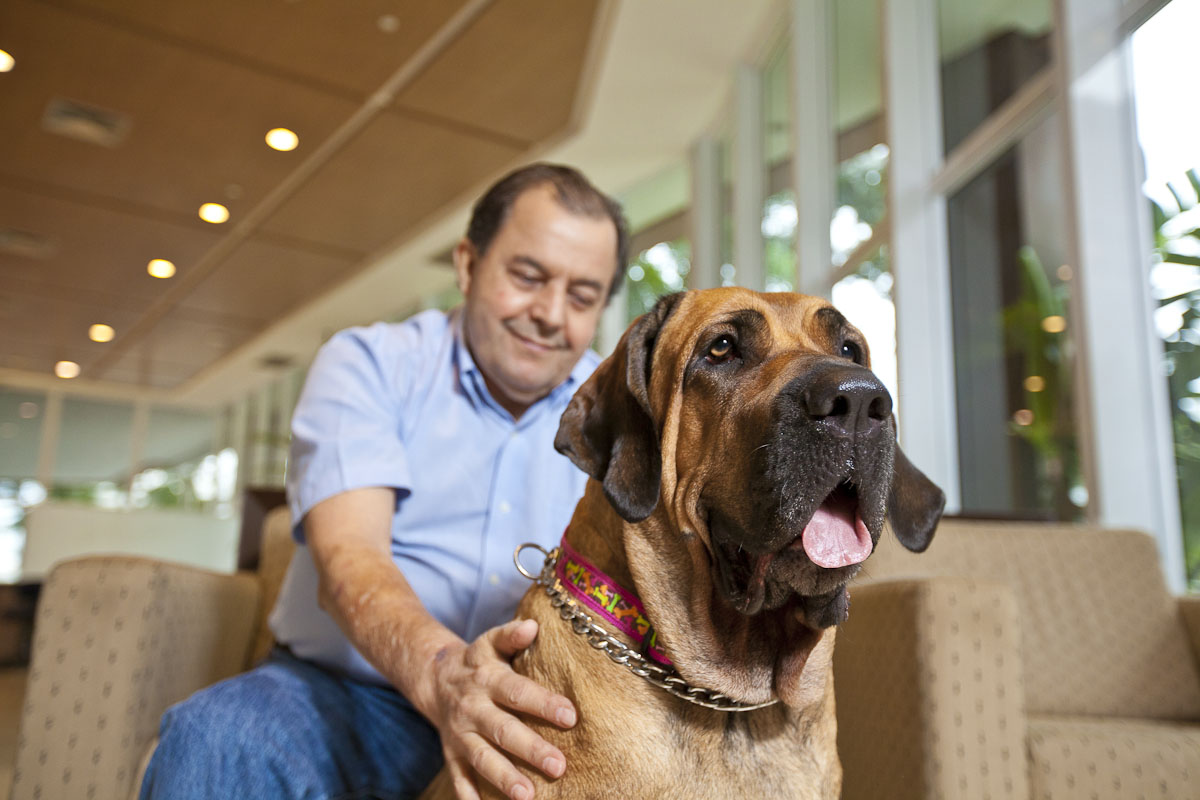
A man in hospital for chemotherapy treatment receives a visit from his dog, Clara.
The connection between pets and people is profound. They not only provide a happy welcome at the end of the day, our animal companions can help us keep fit, promote social interactions and lower stress.
So it’s not surprising to see there are benefits for patients in hospitals as well.
While pet visitation programs in hospitals aren’t new, they have been in the news recently emphasizing the positives associated with our animal companions.
“In hospice and cared living, there is much more interaction when an animal is there,” says Jason Coe, a professor in the Department of Population Medicine. “Animals create conversation that carries on even when they are not there. The social benefits of the human interaction are driven by the social benefits of the animal interaction.”
To ensure the benefits are realized, some common-sense strategies need to come into play with pet visitation.
“Like everything there’s going to be risks and benefits,” says Coe. “I think there’s a huge opportunity in terms of managing those risks, so we can maximize the benefit of the human-animal relationship. Fortunately we can manage a lot of the risks if we have proper veterinary care associated with animals.”
Most programs in health-care facilities are specialized pet visitation programs that encompass social and emotional interaction, says Scott Weese, pathobiology professor and Canada Research Chair in Zoonotic Diseases.
“The other piece is bringing personal pets into health-care facilities — that’s less organized,” he says. “That’s where the risk comes in. Less structure, less scrutiny and the risks will increase.”
Weese has co-authored two rounds of recommendations focused on reducing risks with animals in health-care facilities. The latest was in 2015, led by the Society for Healthcare Epidemiology of America (SHEA), a leading hospital epidemiology group.
The recommended guidelines cover animals in health-care settings, including therapy, service and research animals, as well as personal pet visitation.
“These guidelines were prompted by the medical field, showing their interest in this and recognition of the benefits of these types of programs,” he says.
Weese says hospital pet visitation guidelines often focus on vaccination against canine diseases which, with the exception of rabies, do nothing to protect people, instead of focusing on the animal’s behaviour, training handlers properly or ensuring effective hygiene.
Dogs are most often used in visitation programs for good reasons. “We know how to assess them, we know the potential diseases, and we have evidence that visitation with dogs can improve patients’ health and welfare,” says Weese.
Veterinarians have an important role in the success of pet visitation programs, ideally by flagging visitation dogs in their records. For example, if an animal develops an infection or an orthopedic condition, it may affect its infectious disease risk or behaviour, adds Weese.
It’s important to train handlers properly, to select low-risk animals that have been temperament-tested and use common sense when it comes to hygiene. This includes hand-washing for the handler before and after visiting a patient, and for the patient before and after handling the pet; having a plan in place to deal with any accidental animal waste; not letting animals lick the patient’s face or wounds; and using a barrier such as a towel or sheet if the animal is on the bed with a sick person.
People involved with pet visitation programs need to be provided with the right information and tools. “Well-meaning dog owners shouldn’t be expected to know about infection control,” says Weese.“It has to be common sense for everyone involved and not just common sense for the people who write the guidelines. It’s not hard to do it right.”
Photo: Zé Carlos Barretta